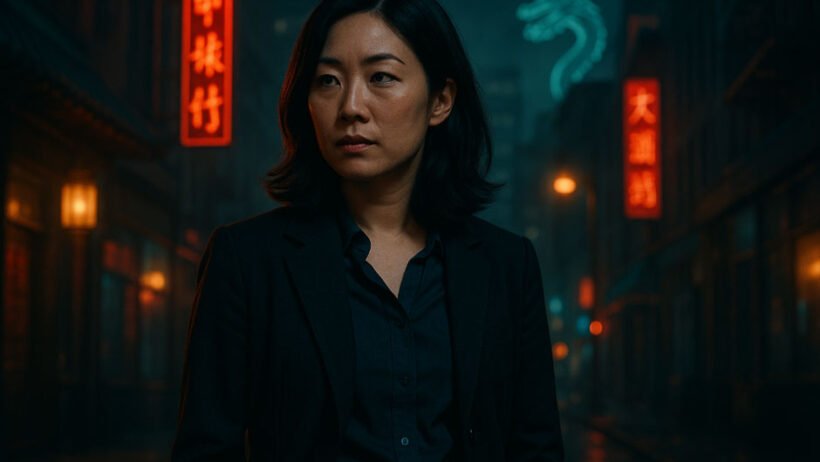Introduction – Who is Lana Lee?
When Detective Lana Lee first appeared on screens in Hulu’s “Interior Chinatown,” viewers immediately sensed something different about this character. Unlike typical procedural detectives, Lana Lee carries the weight of representation on her shoulders while navigating her own complex identity crisis.
Chloe Bennet’s portrayal of this character has resonated far beyond the show’s November 2024 premiere. The series, adapted from Charles Yu’s acclaimed novel, doesn’t just tell another crime story. Instead, it uses the familiar procedural format to examine how Asian-American characters are often positioned in mainstream television.
Lana Lee emerges as a central figure who embodies the complexities of navigating multiple worlds simultaneously. Her presence on screen immediately challenges conventional expectations and opens discussions about the role of Asian-American characters in mainstream television.
The Character Behind the Badge
The circumstances surrounding Lana Lee’s introduction tell us everything we need to know about her predicament. When she joins the investigation, it’s explicitly for “cultural considerations” – a phrase that makes both the character and viewers cringe. The irony cuts deep: she’s expected to understand a community she knows nothing about.
This setup isn’t accidental. It reflects a reality many Asian-American actors know well – being cast not for their individual talents, but as cultural translators. Lana Lee becomes the embodiment of this problematic dynamic.
What makes her character particularly compelling is how she navigates this impossible position. She’s neither fully accepted by the procedural world she’s entered nor genuinely connected to the community she’s supposed to represent.
Chloe Bennet’s Personal Connection to Lana Lee
Chloe Bennet didn’t just audition for this role – she fought for it. The character spoke to something deep in her own experience as a mixed-race performer who’d spent years being typecast in similar “bridge” roles.
Bennet’s seven seasons on “Agents of S.H.I.E.L.D.” had taught her what it felt like to be the cultural connector on set. She’d been there before, serving as the link between different worlds while rarely being seen as a destination herself.
When she read Charles Yu’s novel, something clicked. Here was a story that articulated feelings she’d carried for years but struggled to express. Playing Lana Lee became more than work – it was therapy, a chance to process her own complicated relationship with representation in Hollywood.
Identity Crisis and Cultural Navigation
Lana Lee’s internal struggle isn’t subtle – it’s written into every scene she appears in. She exists in a constant state of not quite belonging anywhere, which Bennet describes as an ongoing identity crisis.
The metaphor Bennet uses hits particularly hard: “When you’re constantly the bridge, you’re not really a destination. You’re just a vessel.” This captures something essential about Lana Lee’s experience and, by extension, the experience of many mixed-race individuals in entertainment.
The character can’t simply be herself because everyone around her has expectations about what she should represent. She’s caught between worlds that each claim her partially but never completely.
From Novel to Screen – Character Development
The transition from Charles Yu’s novel to the television adaptation involved significant character development. Originally named Karen in the source material, the character became Lana Lee for the screen version, reflecting the collaborative creative process.
Bennet’s involvement in shaping the character extended beyond simply performing the role. She worked closely with creator Charles Yu to develop Lana’s backstory and motivations, ensuring the character possessed sufficient depth for multiple viewings.
This collaborative approach resulted in a character with layers that reveal themselves upon closer examination. Bennet deliberately crafted her performance to reward viewers who return to the series with new understanding of the character’s true nature.
The Broader Impact of Lana Lee’s Representation
Lana Lee’s significance extends beyond the confines of “Interior Chinatown” itself. The character represents a new approach to Asian-American representation in mainstream television, one that acknowledges the complexity of cultural identity.
Rather than serving as a simple diversity checkbox, Lana Lee confronts the very mechanisms that create such tokenistic representation. The character’s struggles mirror real-world experiences of individuals who find themselves cast in similar roles.
The show’s approach to representation has sparked important conversations within the entertainment industry. By making the character’s representational burden explicit, “Interior Chinatown” forces viewers to examine their own expectations and assumptions.
Performance and Acting Craft
Bennet’s approach to portraying Lana Lee involved careful attention to grounding the character in recognizable human experiences. She focused on small details that would make the character feel authentic and relatable.
The actress worked to ensure that Lana Lee’s emotional journey remained accessible to audiences while maintaining the character’s complexity. This balance required subtle performance choices that could convey multiple layers of meaning.
Bennet’s commitment to the role extended to her preparation process. She felt so strongly about playing Lana Lee that she considered it essential to her career, believing she would need to quit acting if she couldn’t bring this particular character to life.
Conclusion – Lana Lee’s Legacy in Television
Lana Lee represents something new in television – a character who doesn’t just happen to be Asian-American, but whose Asian-American experience is central to her story. She’s not there to check a diversity box or provide cultural exposition for white characters.
The conversations sparked by her character extend far beyond the show itself. Industry professionals are taking notice of how “Interior Chinatown” handles representation, and many are asking whether their own projects could benefit from similar honesty about these dynamics.
What makes Lana Lee’s story particularly powerful is its refusal to offer easy answers. She doesn’t overcome her identity crisis by the end of the season – she learns to live with it, to find strength in the complexity rather than resolution in simplicity. That feels more honest than most television is willing to be.








